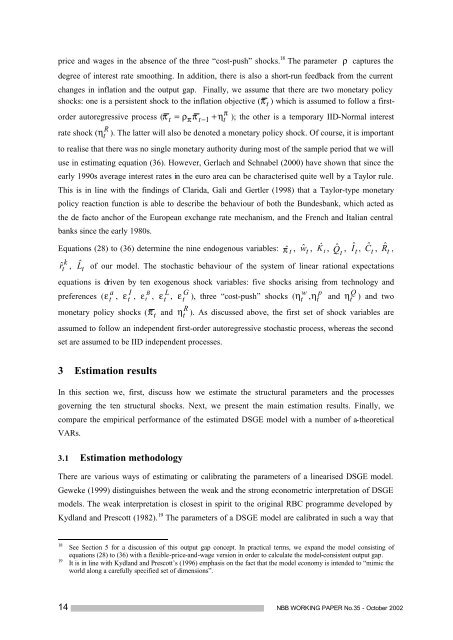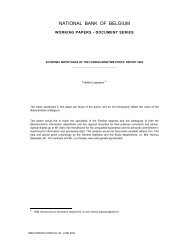An estimated dynamic stochastic general equilibrium model of the ...
An estimated dynamic stochastic general equilibrium model of the ...
An estimated dynamic stochastic general equilibrium model of the ...
You also want an ePaper? Increase the reach of your titles
YUMPU automatically turns print PDFs into web optimized ePapers that Google loves.
price and wages in <strong>the</strong> absence <strong>of</strong> <strong>the</strong> three “cost-push” shocks. 18 The parameter ρ captures <strong>the</strong>degree <strong>of</strong> interest rate smoothing. In addition, <strong>the</strong>re is also a short-run feedback from <strong>the</strong> currentchanges in inflation and <strong>the</strong> output gap. Finally, we assume that <strong>the</strong>re are two monetary policyshocks: one is a persistent shock to <strong>the</strong> inflation objective ( π t ) which is assumed to follow a firstorderautoregressive process ( π t = ρππt−1 + ηt); <strong>the</strong> o<strong>the</strong>r is a temporary IID-Normal interestπRrate shock ( η t ). The latter will also be denoted a monetary policy shock. Of course, it is importantto realise that <strong>the</strong>re was no single monetary authority during most <strong>of</strong> <strong>the</strong> sample period that we willuse in estimating equation (36). However, Gerlach and Schnabel (2000) have shown that since <strong>the</strong>early 1990s average interest rates in <strong>the</strong> euro area can be characterised quite well by a Taylor rule.This is in line with <strong>the</strong> findings <strong>of</strong> Clarida, Gali and Gertler (1998) that a Taylor-type monetarypolicy reaction function is able to describe <strong>the</strong> behaviour <strong>of</strong> both <strong>the</strong> Bundesbank, which acted as<strong>the</strong> de facto anchor <strong>of</strong> <strong>the</strong> European exchange rate mechanism, and <strong>the</strong> French and Italian centralbanks since <strong>the</strong> early 1980s.Equations (28) to (36) determine <strong>the</strong> nine endogenous variables: πˆ t ,krˆ t ,ŵ t ,Kˆ t , Qˆ t, Î t ,Lˆt <strong>of</strong> our <strong>model</strong>. The <strong>stochastic</strong> behaviour <strong>of</strong> <strong>the</strong> system <strong>of</strong> linear rational expectationsequations is driven by ten exogenous shock variables: five shocks arising from technology anda I B L Gw p Qpreferences ( ε t , ε t , ε t , ε t , ε t ), three “cost-push” shocks ( η t , η t and η t ) and twoRmonetary policy shocks ( π t and η t ). As discussed above, <strong>the</strong> first set <strong>of</strong> shock variables areassumed to follow an independent first-order autoregressive <strong>stochastic</strong> process, whereas <strong>the</strong> secondset are assumed to be IID independent processes.Ĉ t ,Rˆt ,3 Estimation resultsIn this section we, first, discuss how we estimate <strong>the</strong> structural parameters and <strong>the</strong> processesgoverning <strong>the</strong> ten structural shocks. Next, we present <strong>the</strong> main estimation results. Finally, wecompare <strong>the</strong> empirical performance <strong>of</strong> <strong>the</strong> <strong>estimated</strong> DSGE <strong>model</strong> with a number <strong>of</strong> a-<strong>the</strong>oreticalVARs.3.1 Estimation methodologyThere are various ways <strong>of</strong> estimating or calibrating <strong>the</strong> parameters <strong>of</strong> a linearised DSGE <strong>model</strong>.Geweke (1999) distinguishes between <strong>the</strong> weak and <strong>the</strong> strong econometric interpretation <strong>of</strong> DSGE<strong>model</strong>s. The weak interpretation is closest in spirit to <strong>the</strong> original RBC programme developed byKydland and Prescott (1982). 19 The parameters <strong>of</strong> a DSGE <strong>model</strong> are calibrated in such a way that1819See Section 5 for a discussion <strong>of</strong> this output gap concept. In practical terms, we expand <strong>the</strong> <strong>model</strong> consisting <strong>of</strong>equations (28) to (36) with a flexible-price-and-wage version in order to calculate <strong>the</strong> <strong>model</strong>-consistent output gap.It is in line with Kydland and Prescott’s (1996) emphasis on <strong>the</strong> fact that <strong>the</strong> <strong>model</strong> economy is intended to “mimic <strong>the</strong>world along a carefully specified set <strong>of</strong> dimensions”.14 NBB WORKING PAPER No.35 - October 2002
















